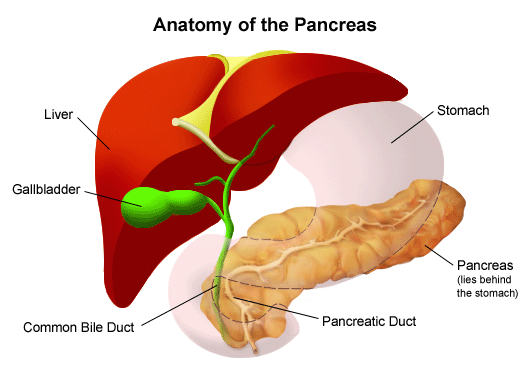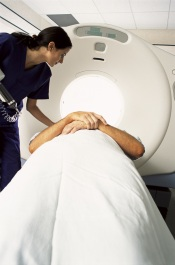
Computed tomography (CT) scan is a noninvasive diagnostic imaging procedure that uses a combination of X-rays and computer technology to produce horizontal, or axial, images (often called slices) of the body. A CT scan shows detailed images of any part of the body, including the bones, muscles, fat, and organs. CT scans are more detailed than standard X-rays.
In standard X-rays, a beam of energy is aimed at the body part being studied. A plate behind the body part captures the variations of the energy beam after it passes through skin, bone, muscle, and other tissue. While much information can be obtained from a standard X-ray, a lot of detail about internal organs and other structures is not available.
In computed tomography, the X-ray beam moves in a circle around the body. This allows many different views of the same organ or structure. The X-ray information is sent to a computer that interprets the X-ray data and displays it in a two-dimensional (2D) form on a monitor.
CT scans may be done with or without "contrast." Contrast refers to a substance taken by mouth or injected into an intravenous (IV) line that causes the particular organ or tissue under study to be seen more clearly. Contrast examinations may require you to fast for a certain period of time before the procedure. Your doctor will notify you of this prior to the procedure.
CT scans of the pancreas can provide more detailed information about the pancreas than standard X-rays of the abdomen, thus providing more information related to injuries and/or diseases of the pancreas. CT scans of the pancreas are useful in the diagnosis cancer of the pancreas and pancreatitis.

The pancreas is an elongated, tapered organ, about 6 inches long, located across the back of the abdomen, and behind the stomach. The right side of the organ (called the head) is the widest part of the organ and lies in the curve of the duodenum (the first section of the small intestine). The tapered left side extends slightly upward (called the body of the pancreas) and ends near the spleen (called the tail) in the upper left part of the abdomen.
The pancreas is made up of 2 types of glands:
The pancreas has digestive and hormonal functions:
A CT scan of the pancreas may be performed to assess the pancreas for tumors and other lesions, injuries, bleeding, infections, abscesses, unexplained abdominal pain, obstructions, or other conditions, particularly when another type of examination, such as X-rays or physical examination, is not conclusive.
CT scans of the pancreas may be used to distinguish between disorders of the pancreas and disorders of the retroperitoneum (the back portion of the abdomen behind the peritoneal membrane).
There may be other reasons for your doctor to recommend a CT scan of the pancreas.
You may want to ask your doctor about the amount of radiation used during the CT procedure and the risks related to your particular situation. It is a good idea to keep a record of your past history of radiation exposure, such as previous CT scans and other types of X-rays, so that you can inform your doctor. Risks associated with radiation exposure may be related to the cumulative number of X-ray examinations and/or treatments over a long period of time.
If you are pregnant or suspect that you may be pregnant, you should notify your doctor. Radiation exposure during pregnancy may lead to birth defects.
If contrast media is used, there is a risk for allergic reaction to the media. Patients who are allergic to or sensitive to medications should notify their doctor. You will need to let your doctor know if you have ever had a reaction to any contrast media, and/or any kidney problems. A reported seafood allergy is not considered to be a contraindication for iodinated contrast. If you are taking metformin/Glucophage or a related medication, you may be asked to stop taking it for at least 48 hours after receiving the contrast, as it may cause a condition known as metabolic acidosis, or an unsafe change in your blood pH.
Patients with kidney failure or other kidney problems should notify their doctor. In some cases, the contrast media can cause kidney failure, especially if the person is dehydrated or has underlying kidney problems.
There may be other risks depending on your specific medical condition. Be sure to discuss any concerns with your doctor prior to the procedure.
Certain factors or conditions may interfere with the accuracy of a CT scan of the pancreas. These factors include, but are not limited to, the following:
If you are having a computed tomography angiography (CTA) with Johns Hopkins radiology, you will be given specific instructions when you make your appointment.
PRECAUTIONS: If you are pregnant or think you may be pregnant, please check with your doctor before scheduling the exam. Other options will be discussed with you and your doctor.
CLOTHING: You may be asked to change into a patient gown. If so, a gown will be provided for you. A locker will be provided to secure personal belongings. Please remove all piercings and leave all jewelry and valuables at home.
CONTRAST MEDIA: CT scans are most frequently done with and without a contrast media. The contrast media improves the radiologist's ability to view the images of the inside of the body.
ALLERGY: Please inform the access center representative when you schedule your CT scan if you have had an allergic reaction to any contrast media. IV contrast will not be administered if you have had a severe or anaphylactic reaction to any contrast media in the past. If you had mild to moderate reactions in the past, you will likely need to take medication prior to the CT scan. These plans will be discussed with you in detail when you schedule your exam. Any known reactions to a contrast media should be discussed with your personal physician.
EAT/DRINK: If your doctor ordered a CT scan without contrast, you can eat, drink and take your prescribed medications prior to your exam. If your doctor ordered a CT scan with contrast, do not eat anything three hours prior to your CT scan. You are encouraged to drink clear liquids. You may also take your prescribed medications prior to your exam.
DIABETICS: Diabetics should eat a light breakfast or lunch three hours prior to the scan time. Depending on your oral medication for diabetes, you may be asked to discontinue use of the medication for 48 hours after the CT scan. If you have a CT scan with Johns Hopkins radiology, detailed instructions will be given following your examination.
MEDICATION: All patients can take their prescribed medications as usual.
Based on your medical condition, your doctor may request other specific preparation.

CT scans may be performed on an outpatient basis or as part of your stay in a hospital. Procedures may vary depending on your condition and your physician's practices.
Generally, a CT scan follows this process:
While the CT procedure itself causes no pain, having to lie still for the length of the procedure might cause some discomfort or pain, particularly in the case of a recent injury or invasive procedure such as surgery. The technologist will use all possible comfort measures and complete the procedure as quickly as possible to minimize any discomfort or pain.
If contrast media was used during your procedure, you may be monitored for a period of time for any side effects or reactions to the contrast media, such as itching, swelling, rash, or difficulty breathing.
If you notice any pain, redness, and/or swelling at the IV site after you return home following your procedure, you should notify your doctor as this could indicate an infection or other type of reaction.
Otherwise, there is no special type of care required after a CT scan of the pancreas. You may resume your usual diet and activities unless your doctor advises you differently. Your doctor may give you additional instructions after the procedure, depending on your particular situation.
Find Additional Treatment Centers at: